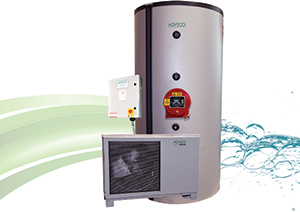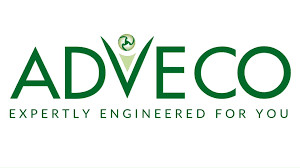For more than fifty years, Adveco has been a leading innovator providing hot water (DHW) for commercial-scale projects across the UK. Today its focus is shifting to encompass a blend of traditional and new, more sustainable technologies in the form of solar thermal for those on gas and especially heat pumps for new builds to integrate greater sustainability into DHW systems.
With a predicted one-third rise in non-domestic floor space by 2050, much of the current focus resides on new builds, but this still leaves more than 1.6 million pre-existing non-domestic buildings in England and Wales, generating almost one-fifth of the UK’s carbon emissions, needing expert, practical support.
Air source heat pumps (ASHP) have become the poster child technology for the government’s net zero strategy. The advantage of ASHPs is that, with a performance greater than 100%, they can extract additional energy from outside of the building’s metered systems delivering significant carbon savings. For a commercial DHW system, it is recommended that a working water temperature from the ASHP, such as Adveco’s FPi32 or L70, must be at least 55°C.
 This is certainly attainable from current generation ASHPs when deployed in a hybrid approach. This uses the ASHP as preheat and combines it with either gas-fired or more preferably an electric top-up to achieve the required hot water temperature. This is where the additional system complexity and cost can creep in. But by correctly balancing a system through a mix of physical spacing in the vessel and system monitoring with dedicated controls, as developed for the Adveco FUSION, the system no longer fights itself, working seamlessly to deliver the highest operational efficiencies
This is certainly attainable from current generation ASHPs when deployed in a hybrid approach. This uses the ASHP as preheat and combines it with either gas-fired or more preferably an electric top-up to achieve the required hot water temperature. This is where the additional system complexity and cost can creep in. But by correctly balancing a system through a mix of physical spacing in the vessel and system monitoring with dedicated controls, as developed for the Adveco FUSION, the system no longer fights itself, working seamlessly to deliver the highest operational efficiencies
In line with the European Commission’s proposal for a tightening of F-Gas regulations, development work continues at pace to support the introduction of R290, or propane as it is more commonly known. This refrigerant offers a coefficient of performance (COP) that enables working flow temperatures from an ASHP of up to 75°C and potentially much higher. This means future commercial systems can be less complex, without the need for additional electric immersion for high-temperature flushing for legionella protection. That said, immersions remain perfectly suitable for low-demand backup applications in boiler-fed indirect cylinders, ensuring business-critical DHW demands are met.
What we have seen more recently though is a shift in use, where immersions are used ‘directly’ in high-demand commercial applications as the primary heat source. An electric immersion heater has a high heat intensity compared to gas or indirect and, when coupled with high operating temperatures and hard water will increase the rate of scale formation which, over time, will cause the element to rupture.
In response, protecting a system from limescale is often only addressed by a vigorous cleaning regime. This method has a cost and downtime associated with it that is not acceptable for many commercial buildings. For this reason, minimisation of scale formation with water softener or a scale inhibitor may be adopted, but for many sites neither provides a satisfactory response because of space, maintenance, downtime, or cost. A better option for these sites would be to replace the immersion heaters with a low scale forming hot water system.
The new Adveco electric boiler range provides a proven and cost-effective answer. The boiler still utilises immersion heaters located in a small tank heat exchanger within the boiler housing. This electric boiler supplies a sealed ‘primary’ loop to an indirect coil in the cylinder. The electric boiler heats the same water continuously so there is only a finite amount of scale in the system which will not damage the elements. The heat exchanger in the cylinder is a large coil operating at relatively low temperatures. Adveco’s extensive experience with indirect coil use in the UK has shown that scale is not a significant problem in these systems. The electric boiler operates at the same efficiency as an electric immersion heater (100%) so the only overall difference in system efficiency is the minimal pump electrical consumption and a small amount of heat loss in the pipework.
An electric boiler hot water system will take up a little more space than an all-in-one electric cylinder, but it has more versatility and requires less clearance for the cylinder. Similarly priced to an immersion heater, an electric boiler-based system will cost slightly more due to the small amount of additional installation work. But with virtually no maintenance and the cylinder forming significantly less scale, vastly improving reliability, the operational and maintenance savings will offset these additional capital costs. The electric boiler additionally offers a level of redundancy that is not achieved with a single immersion heater.
As limitation on new gas grid connections for heating systems becomes effective this year, it will become critical for system longevity to recognise the new challenges electric-only presents over more familiar gas-based applications.
But if a business already uses gas, the application of solar thermal with Adveco’s built-in drainback functionality, can really improve the sustainability of a building’s DHW system. When used as a preheat with coldest water possible to maximise the efficiency and output, solar thermal remains the best option, maximising free heat with no additional carbon emissions. This is an important consideration given buildings with an existing connection can still upgrade to new gas appliances until 2035, with 100% hydrogen-ready options extending that window well into the 2040s based on current appliance lifespan.
Adveco continues to support the refurbishment of existing buildings, recently extending its ranges of direct-fired condensing water heaters – the AD and the ADplus. Both ranges provide a compact, floor-standing design that is easy to introduce into an existing plant room to provide high-demand semi-instantaneous and instantaneous hot water applications. Improved combustion efficiency means the burner requires less gas, delivering up to 30% savings in fuel consumption, making it more cost-effective, while reducing emissions.
For smaller on-demand needs, ADplus heats only what is necessary, with no ignition for smaller withdrawals providing considerable additional energy savings. Both AD and ADplus as a result exhibit ultra-low NOX (Class 6 appliance at 27 mg/kWh) and CO emissions (19ppm). With the government already committed to enabling the blending of hydrogen in the gas grid it is also worth noting that these latest generation direct-fired condensing water heaters will already support the initial 20% hydrogen/natural gas blend.
Together, these technologies offer actual development arcs right now for existing commercial properties that are currently on-gas, or new builds seeking to embrace low or no emission choices to deliver more sustainable operations that will help achieve net zero by 2050.
Contact
www.adveco.co

